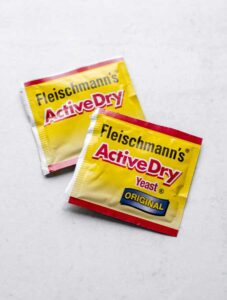Did you know your oven temperature might not actually be what it says on the dial? That's why you should use an oven thermometer to improve your baking!
I recently moved to a new house, and while I was looking forward to a change of scenery, there was one thing I was dreading: adjusting to baking in a new oven.
And that's because ovens can be so finicky!
After baking a few batches of cookies and muffins, I had a sneaking suspicion that the internal oven temperature wasn't matching the temperature listed on the dial.
I decided to pick up an oven thermometer to check the internal temperature of the oven... and it was 25°F cooler than it said it was on the dial.
So, in case you find yourself in a similar situation, I wanted to explain how oven thermometers work, how to properly use them, and how they can help improve your baking.
Jump to:
What is an Oven Thermometer?
An oven thermometer is a small, stainless steel, oven-safe thermometer you can use to check the internal temperature of an oven. It's typically designed so that you can hang it from one of your oven racks.
Then, once you get a reading on the internal temperature of your oven, you can compare that temperature to the one listed on the oven dial. Chances are it might not be the same number!
You can typically buy an oven thermometer at any kitchen supply store, or you can purchase one on Amazon for typically less than $10.
How to Use an Oven Thermometer
So... how do you actually use an oven thermometer? It's easier than you may think!
Here's all you need to do:
- Clip the oven thermometer to your oven rack and preheat the oven. Let the oven heat up, then check the temperature listed on the thermometer.
- Be careful not to open your oven door too much. Opening the oven door lets the heat out of the oven, which can impact the temperature reading. It's best to take the temperature reading by looking through the oven door. If you need to open the oven door to take the reading, do it as quickly as possible.
- Move the thermometer around to various spots in your oven. Move the thermometer from right to left, and try transferring it to a different rack. This will help you see if there are any hot or cold spots in your oven.
- If desired, recalibrate the oven. If you don't want to have to keep the temperature difference in mind each time you use the oven, you can consider actually recalibrating the oven. Here are some instructions on how to do that yourself, or you can call a professional to assist you with the process.
Why Oven Thermometers Can Improve Your Baking
Knowing the actual temperature of your oven can really help you level up your baking by ensuring more exact cooking times and results.
For instance, if you discover (like me) that your oven's internal temperature is 25°F cooler than the temperature listed on the dial, you can use adjust accordingly for each recipe.
If you're following a recipe that tells you to bake snickerdoodles at 350°F, simply preheat your oven to 375°F instead and see how much better your cookies turn out!
I personally like to just leave my oven thermometer in my oven at all times. It's a really simple step that helps me feel a lot more confident when baking, and I know it will help you out too.





















Comments
No Comments